REDIRECT to ARCHIVES OF THE TIDAL CURRENT ENERGY PROJECT 2006-2011

These pictures were taken before restoration of the Race Rocks Lighthouse in 2009-2010
 The Times Colonist ran an article on the problems of the deterioration of the heritage light tower at Race Rocks.Jack Knox and Deborah Brash pay a visit to the tower at the end of January 2007. The following article appears in the Times Colonist.
The Times Colonist ran an article on the problems of the deterioration of the heritage light tower at Race Rocks.Jack Knox and Deborah Brash pay a visit to the tower at the end of January 2007. The following article appears in the Times Colonist.
A beacon of hope for Race Rocks
Carney tries again to win protection for prize lighthouses now withering away, Jack Knox, Times Colonist, Tuesday, Feb. 06, 2007.
|
The Condition at RR
|
February, 2007 | ||
 |
 |
||
| Inside the tower, on the way up the stairs, the walls become pockmarked with condensation blisters | Near the fog sensor, which is set into a south facing window, moisture has caused the wall surface to crumble | The flaking is extensive in the top third of the tower | When the stairs are not swept, there is a continual rain of sand and paint chips. |
 |
 |
 |
|
| Near the window where the counterweight is stationed, the crumbling is particularly obvious. | Looking downstaters at the same window. The yellow flag denotes the top of the stairs. | Even the inside of the lantern room has condensation from the windows loosening the painted surface.The light in the foreground is state of the art in low energy consumption. | Outside at the base of the windows, caulking has deteriorated, allowing driving rains to send moisture inside. |
 |
 |
 |
|
| Wherever iron is exposed, rusting and deterioration sets in.. this is at the base of one of the windows in the lantern room. | Moisture builds up even behind recent painting. | The metal straps underneath the lantern room which help to anchor the top in place are rusted and partly detached from the decaying sandstone wall. | A crack in the lantern room window apparently appeared years ago when the Coast guard was doing blasting for construction on the island |
 |
|||
| Crack width on tower Sept15, 2007 |
Corrosion of steel on railing around lantern room, Sept. 2007 |
Fortunately in 2009-2010 , DFO restored the tower. See this page with pictures taken by the Ecoguardian Ryan Murphy
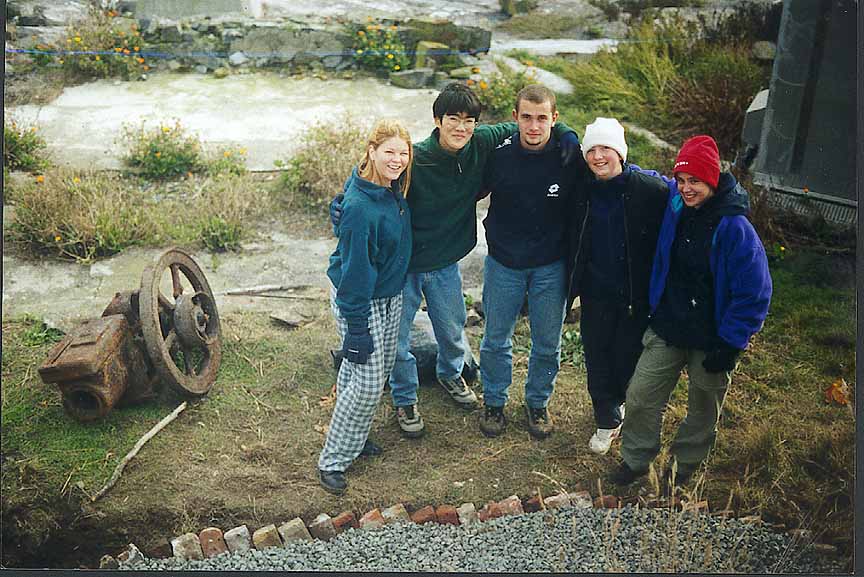 |
 |
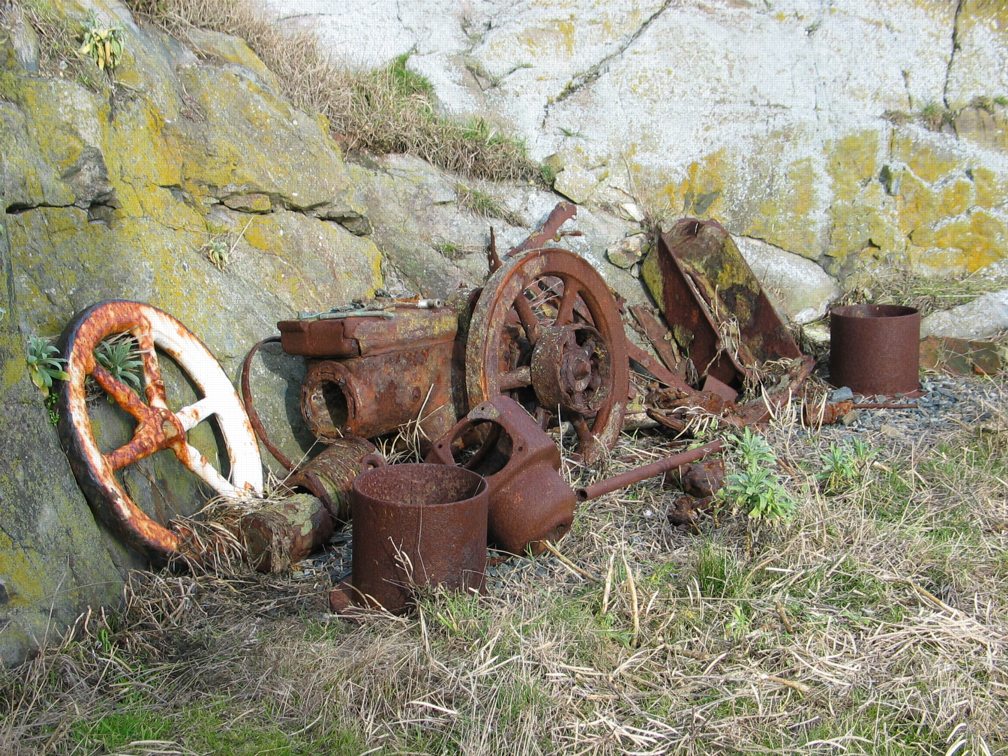 |
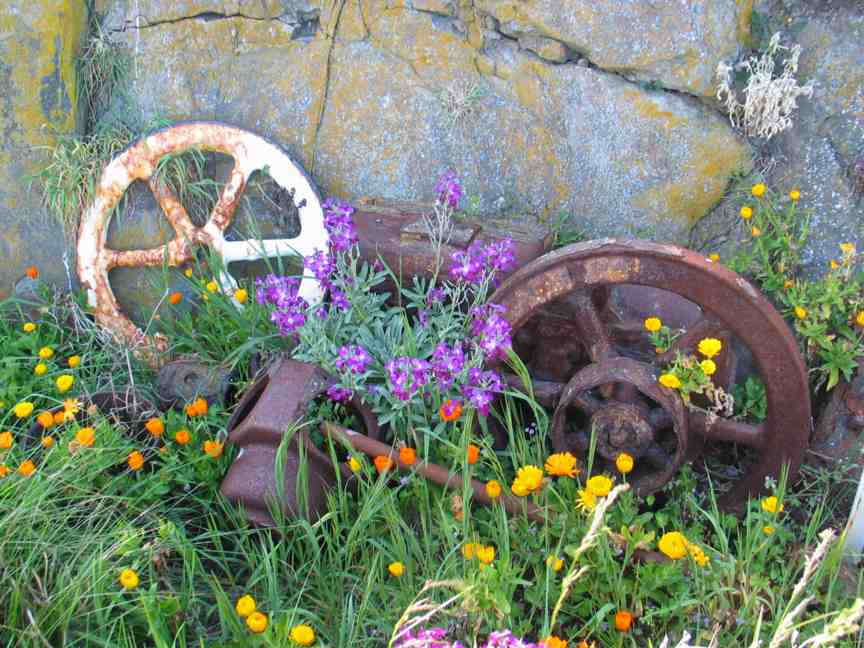 |
| Against the rock wall above the original concrete foundation of the old engine room, and below the tower, a group led by Hannah and Giovanni on one Project week did the digging out of soil, and replacement with crushed rock. . | This allowed the creation of a natural looking corner for the old historic engine room equipment. In this photo Hannah is on the bucket brigade carrying gravel. |
Some of the artifacts that had accumulated by 2005. | In 2006, the area had taken on a life of its own |
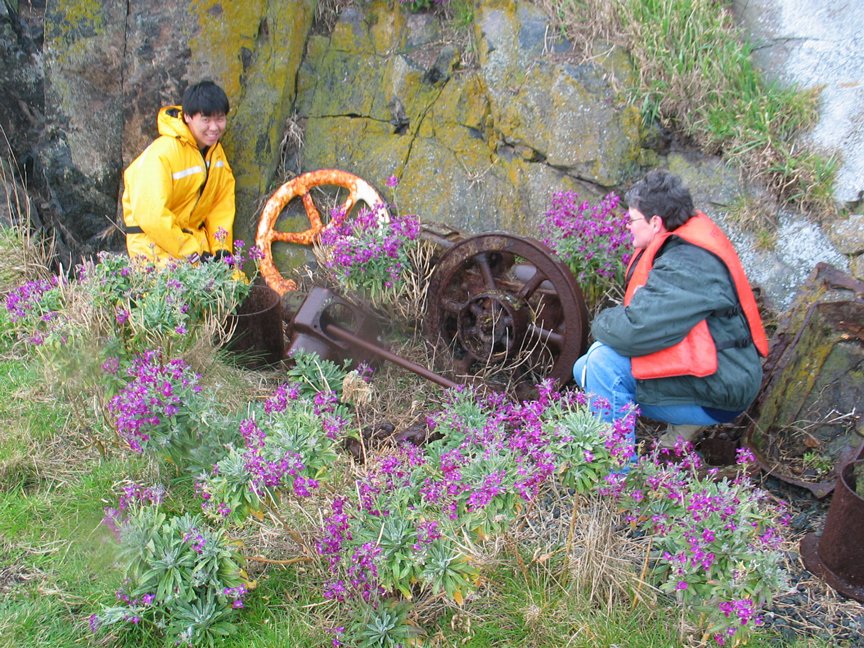 /td> /td> |
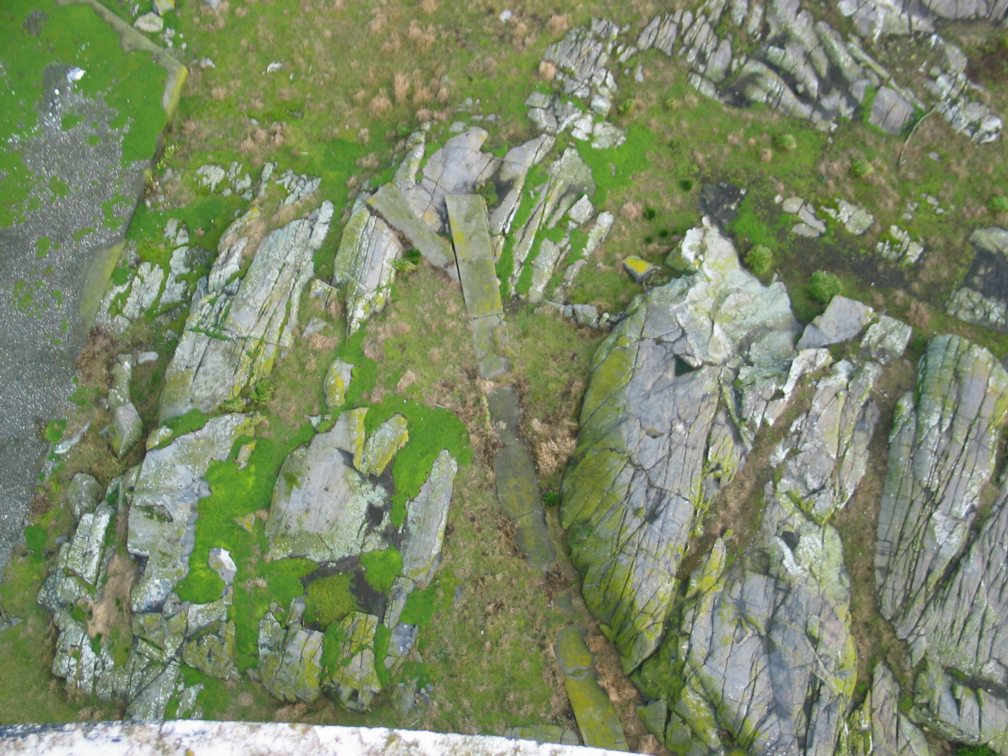 |
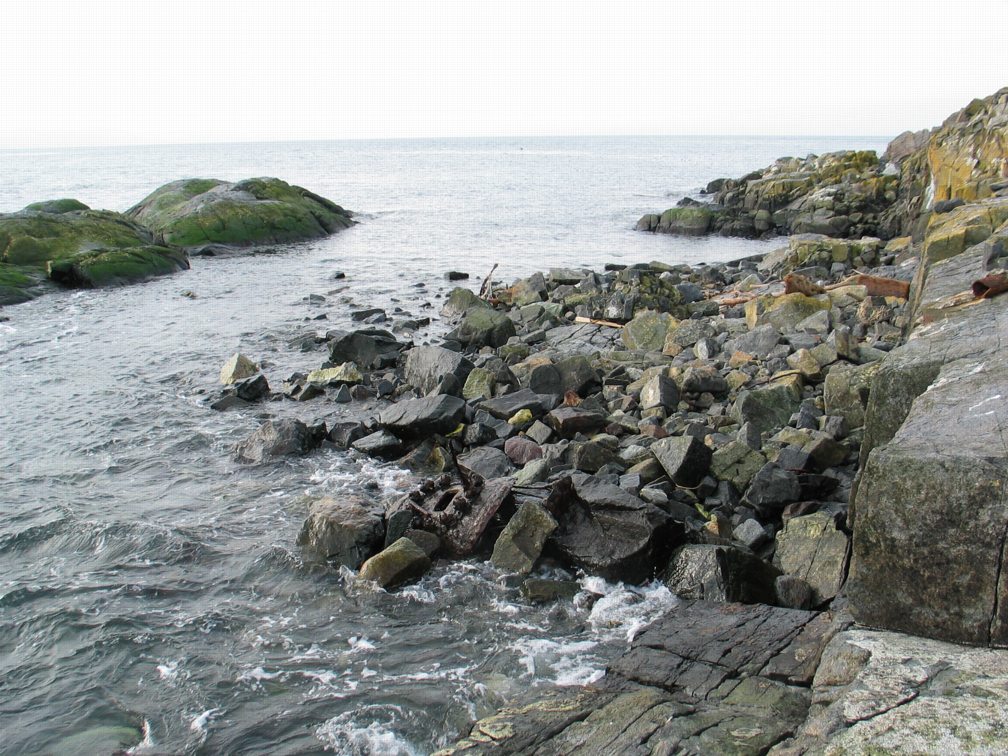 |
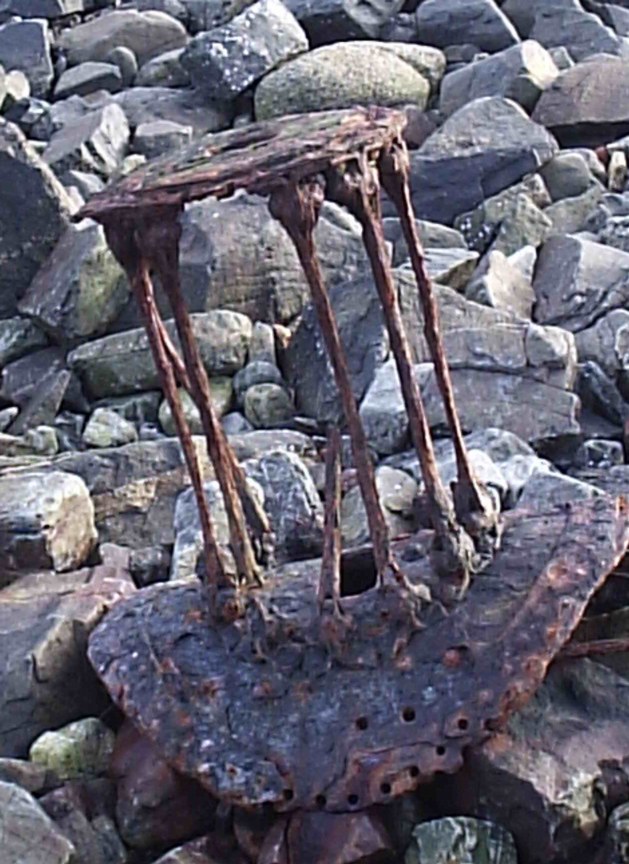 |
| Sylvia and Alex Chan examine the old engine parts. | Looking straight down from the tower on the east side, one can see the concrete pathway which we believe went to the blacksmith shop. | In the past, many old pieces of equipment were simply pushed over the side. | In 2006,the old boiler which lay rusting in the intertidal zone for many years was starting to break up. |
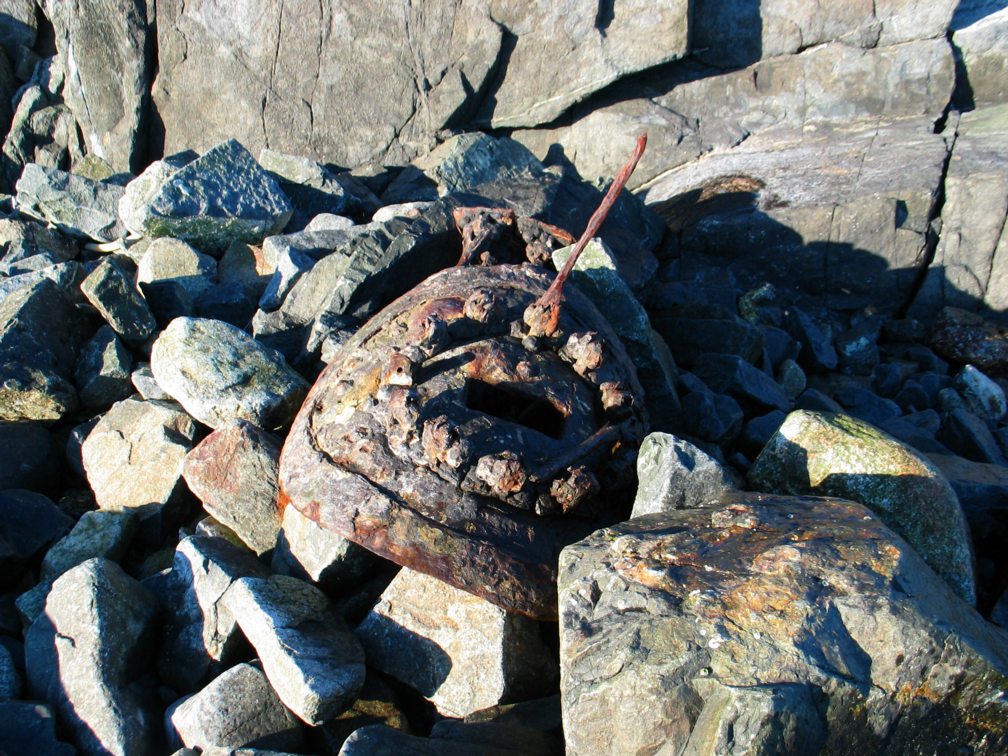 |
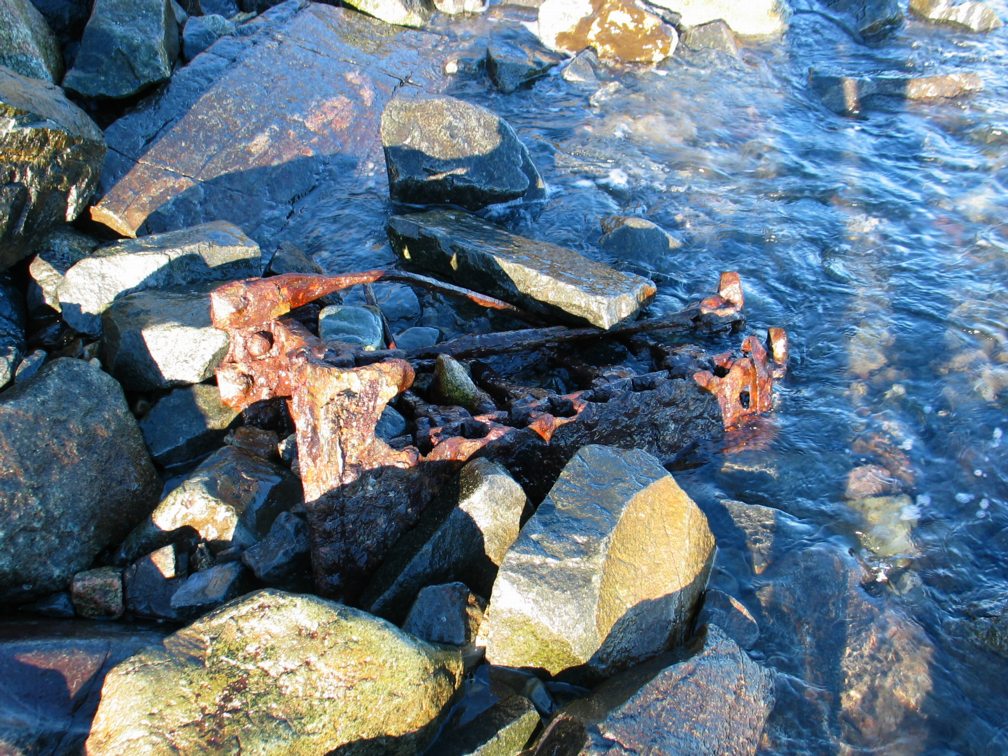 |
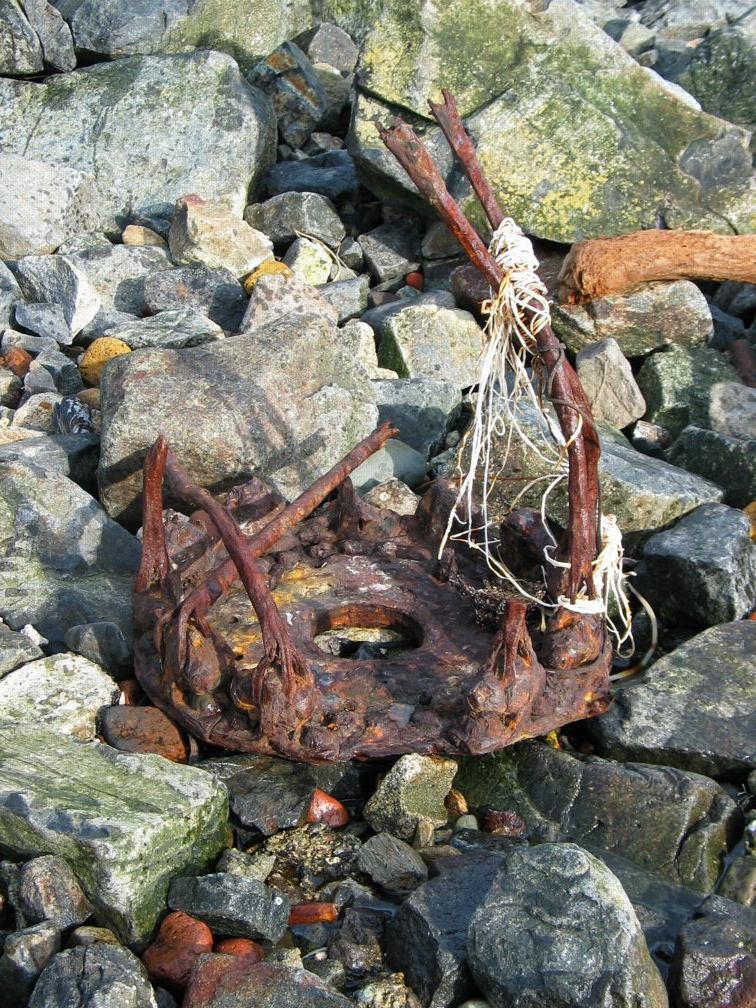 |
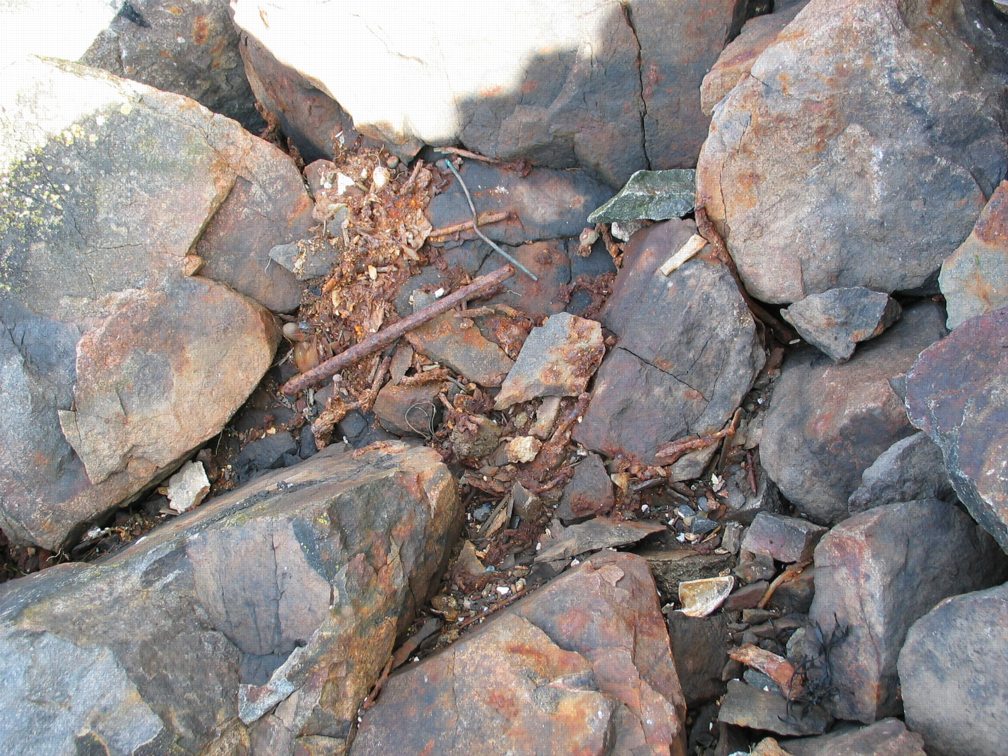 |
| The storms in the winter of 2006 dispersed the parts of the boiler | These pieces which are now small enough to move will be transferred to the collecting area. | The other end of the boiler. This was carried up to shore on February 12, 2007 by members of the racerocks.com activity.See below. | The hurricane in December 2006 moved rocks exposing more rubble below the energy building. |
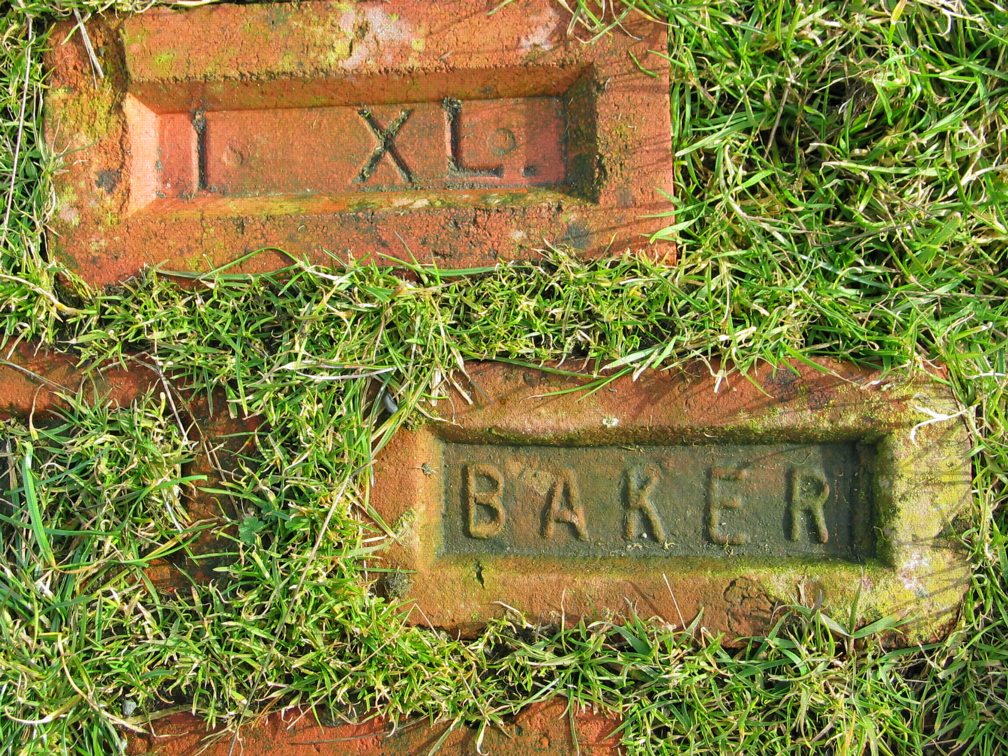 |
|||
| Link to the file on bricks of Race Rocks |
The last of the rusted parts of the old boiler from the engine room shown above are carried up by Pearson College students in the Race Rocks Activity in 2007 to be part of the collection of other old parts stored at the base of the tower.
On February 9, 2007 Senator Pat Carney came to Victoria to present her perspective on the urgency of the Bill in a public meeting at the Maritime Museum. Barry MacDonald, President of the Nova Scotia Lighthouse Preservation Society gave a presentation on lighthouses in need of protection across Canada. He also showed some positive examples of the involvement of local community groups in the successful restoration of divested Lighthouses in Eastern Canada. In a panel discussion, they were joined by Nova Scotia NDP MP Peter Stoffer, (Sackville-Eastern Shore, NS) an ardent supporter of Bill S-220
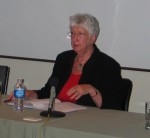 On February 9, 2007 Senator Pat Carney came to Victoria to present her perspective on the urgency of the Bill in a public meeting at the Maritime Museum. |
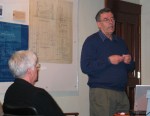 Barry MacDonald, President of the Nova Scotia Lighthouse Preservation Society gave a presentation on lighthouses in need of protection across Canada. |
 He also showed some positive examples of the involvement of local community groups in the successful restoration of divested Lighthouses in Eastern Canada. |
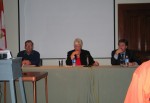 n a panel discussion, they were joined by Nova Scotia NDP MP Peter Stoffer, (Sackville-Eastern Shore, NS) an ardent supporter of Bill S-220 |
 In Jan of 2007 the following article was published in the Victoria Times Colonist: A beacon of hope for Race Rocks
In Jan of 2007 the following article was published in the Victoria Times Colonist: A beacon of hope for Race Rocks
Carney tries again to win protection for prize lighthouses now withering away, Jack Knox, Times Colonist, Tuesday, Feb06, 2007. Over the next two days several e-mails full of documented history came from Dale Mumford who has worked at Fort Rod Hill and Fisgard Lighthouse National Historic Sites for many years. He has provided an update which shows a different interpretation from some of the stories we had collected over the years. So to add to the documented history, we have included his comments and extracts from the original sources here. Fisgard and Race Rocks lighthouses were essentially built at the same time, Fisgard entering service just six weeks before Race Rocks in 1860. In developing exhibits and interpretive programs for Fisgard Lighthouse over the years the staff at the site have had to become very familiar with the early history Fisgard, and of Race Rocks as well. As the two lights were
designed to work together, and were the only lights constructed during the colonial period, we try to explain this relationship in programs for visitors (and virtual visitors). To support this work, we have on hand at the sites copies of many original documents regarding the early construction and operation of the lighthouses. We also have an excellent two volume history of the Fisgard Lighthouse and the Early Lighthouse of British Columbia produced on contract for Parks Canada in 1980. Unfortunately as this work was produced primarily as an in-house document for Parks Canada staff, it was printed only in very limited numbers as part of the Parks Canada Manuscript Report Series and has never been widely available to the public.
Mr.Mumford has invited us to have a look at documents in his possession so we certainly will do this in order to try to get to the bottom of what is the correct version of history of the Lighthouse. ” From these sources, we have been aware that there are a number of inaccurate stories that have been circulating for many years, and have beenrepeated in many books and articles about the original construction of these two lighthouses. It has often been stated that the lighthouses were built by the Royal Navy, and that the lighthouses were designed in Britain and the whole of the building materials were shipped to the colony. In particular with regard to Race Rocks it is often said that all of the stone was pre-cut in Scotland and shipped here like a giant lego set.
In fact, the primary source documents that have survived from 1858 to 1860, and there are many, make it clear that none of this is true. The British government did provide funding for the construction of the two lighthouses, (7,000 pounds, half as a grant and half as a loan), but the construction and operation of the lights was undertaken under the supervision of the Colony of Vancouver Island, (construction specifically under the direction of the colonial surveyor, Joseph Pemberton) and the lighthouses were constructed by local contractors using local materials. The only materials sent from England were the lanterns (in architectural terms the iron and glass lamp rooms at the tops of the towers) and lighting apparatus and stores. In the case of Race Rocks stone for the lower portion of the tower was initially quarried right on the island!
<The treasury officials in providing the funding specified in a letter to the Colonial office dated April 29, 1859 “…that Sir E.B. Lytton will make Governor Douglas fully aware tht altho’ the Board of Trade will readily afford any advice or information , and will send out from this country the lighting apparatus, they decline undertaking responsibilty as to the selection of the site or the construction of the Towers…” The colonial surveyor, J. Pemberton in his original estimates to Gov. Douglas states he planned to quarry rock on the site. In the estimates dated Aug 23rd 1860 he states: ” That brick would be preferable at Esquimalt, and stone quarried on the spot, at Race Rocks, where the distance from Victoria is greater, the currents more rapid, exposure to weather more and Building stone (bluish Granite) excellent.
Richards had already identified the need for lights on the Race Rocks group and at the entrance to Esquimalt harbour in his report of Oct. 1858 which accompanied by letters from Gov. Douglas and Rear-Adm. Baynes, had first requested funding be considered for the two lighthouses, so it is sometimes stated that he chose the sites.”
” If you remain sceptical about some of this information, I can hardly blame you as many of these stories have been repeated over and over in many publications.. ”
Dale Mumford,
Fort Rodd Hill and Fisgard Lighthouse National Historic Sites of Canada *Walbran,Captain John T.,British Columbia Coast Names 1592-1906 : Their Origin and History. First published by the Government Printing Bureau, Ottawa, 1909
It is interesting how different versions of “history” can arise over the relatively short time of almost 150 years. There is still some question about the rock being quarried on site. As it seems that many of the blocks of granite that are still existing from the house which was attached at the base of the tower are of grey granite. The only problem is that most of the existing rock that makes up the island of Race Rocks is a black fractured basalt, and not consistent with the type of rock of the area. So the jury is still out on that one until we can determine the type of stone at the base of the tower. (More on this later!)
An additional note on the history page also confirms that the crew from the British Naval vessel Topaze assisted in the building of the tower.
On the Canadian Coast Guard Site in “USQUE AD MARE,–A History of the Canadian Coast Guard and Marine Services by Thomas E. Appleton” further support for the theory of the granite rock coming from Britain is included:
<Proceed to: CONTEMPORARY HISTORY- 1975-present
For photographs of the Light station in the early years go to this file:
In Jan of 2007 the following article was published in the Victoria Times Colonist:
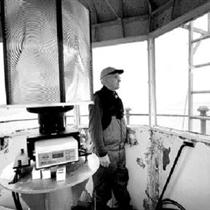 A beacon of hope for Race Rocks
A beacon of hope for Race Rocks
Carney tries again to win protection for prize lighthouses now withering away, Jack Knox, Times Colonist, Tuesday, Feb06, 2007.
. Over the next two days several e-mails full of documented history came from Dale Mumford who has worked at Fort Rod Hill and Fisgard Lighthouse National Historic Sites for many years. He has provided an update which shows a different interpretation from some of the stories we had collected over the years. So to add to the documented history, we have included his comments and extracts from the original sources here. Fisgard and Race Rocks lighthouses were essentially built at the same time, Fisgard entering service just six weeks before Race Rocks in 1860. In developing exhibits and interpretive programs for Fisgard Lighthouse over the years the staff at the site have had to become very familiar with the early history Fisgard, and of Race Rocks as well. As the two lights were designed to work together, and were the only lights constructed during the colonial period, we try to explain this relationship in programs for visitors (and virtual visitors). To support this work, we have on hand at the sites copies of many original documents regarding the early construction and operation of the lighthouses. We also have an excellent two volume history of the Fisgard Lighthouse and the Early Lighthouse of British Columbia produced on contract for Parks Canada in 1980. Unfortunately as this work was produced primarily as an in-house document for Parks Canada staff, it was printed only in very limited numbers as part of the Parks Canada Manuscript Report Series and has never been widely available to the public.
Ed note: Now these publications have been digitized and are available at the following URLS:
http://parkscanadahistory.com/
http://parkscanadahistory.com/
Mr.Mumford has invited us to have a look at documents in his possession so we certainly will do this in order to try to get to the bottom of what is the correct version of history of the Lighthouse. He goes on with
” If you remain sceptical about some of this information, I can hardly blame you as many of these stories have been repeated over and over in many publications.. ”
Dale Mumford,
Fort Rodd Hill and Fisgard Lighthouse National Historic Sites of Canada
Ed Note: It is interesting how different versions of “history” can arise over the relatively short time of 150 years. There is still some question about the rock being quarried on site. As it seems that many of the blocks of granite that are still existing from the house which was attached at the base of the tower are of grey granite. The only problem is that most of the existing rock that makes up the island of Race Rocks is a black fractured basalt, and not consistent with the type of rock of the area. So the jury is still out on that one until we can determine the type of stone at the base of the tower. (More on this later!) There are several examples of Imperial Lights in the British Empire being built with granite from Great Britain. eg. in New Zealand and in South Africa.
An additional note on the history page also confirms that the crew from the British Naval vessel Topaze assisted in the building of the tower.
On the Canadian Coast Guard Site in “USQUE AD MARE,–A History of the Canadian Coast Guard and Marine Services by Thomas E. Appleton” further support for the theory of the granite rock coming from Britain is included:
The 147-year-old tower’s base, built out of Scottish granite, isn’t so bad, but up at the top, salt and water have worked through the sandstone. Outside, on the parapet encircling the light, old orange paint peels off in sheets. Continue reading
These pictures were taken before restoration of the Race Rocks Lighthouse in 2009-2010 Historic Tower. The Times Colonist ran an article on the problems of the deterioration of the heritage light tower at Race Rocks.Jack Knox and Deborah Brash pay a visit to the tower at the end of January 2007. The following article appears in the Times Colonist. “A beacon of hope for Race Rocks Carney tries again to win protection for prize lighthouses now withering away, Jack Knox, Times Colonist, Tuesday, Feb. 06, 2007.
| THE PRESENT CONDITIONS OF THE RACE ROCKS LIGHT TOWER: 2007 Note: These are addressed in 2009: http://www.racerocks.com/racerock/history/restoration/restoration.htm |
| The light tower of Race Rocks is managed by The Canadian Coast Guard as anAid to Navigation. Coast Guard is operated by the Department of Fisheries and Oceans. Currently, there are no funds allocated by this Department for lighthouse restoration, although they are expected to maintain their Aids to Navigation. Parks Canada is responsible for National Historic Sites across Canada. Only one Lighthouse (Fisgard) on the Pacific Coast is provided for by that Department. The Race Rocks Lighthouse, built in 1860 sits on a small parcel of land on Great Race Rocks leased from BC lands. This leased area remains out of the provincial Ecological Reserve. The Ecological reserve covers the remainder of Great Race Rock Island, and the whole area is an MPA designate under the Ocean’s Act of the Fisheries and Oceans Canada.
|